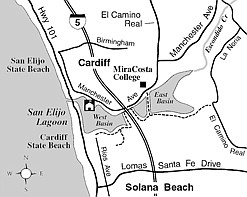 Facebook
Facebook
 X
X
 Instagram
Instagram
 TikTok
TikTok
 Youtube
Youtube
A great blue heron ambles on stilt-legs across the reed-fringed shallows, stabbing occasionally at subsurface morsels of food. A willowy egret glides in for a perfect landing, scattering concentric ripples across the surface of the lagoon. Both birds seem oblivious to binocular-toting humans, who spy on them a comfortable distance away.
A scene like this is repeated almost daily at San Elijo Lagoon. The lagoon is considered the premier birdwatching site in North County. This month, in particular, brings the added excitement of spotting winter migrant birds such as white pelicans. Pelicans, egrets, herons, terns, and a variety of other bird species provide endless entertainment as they go about the business of fishing and feeding in the lagoon’s shallow waters.
West of Interstate 5, in the “West Basin” part of the lagoon, high tides wash over mud flats and mats of salt-tolerant vegetation. Here, a dozen kinds of shorebirds can be seen on a typical day. East of the freeway, the “East Basin” part of the lagoon is higher and drier, and receives some fresh water from local creeks.
Various trailheads serve as entry points for hikes along the lagoon’s shoreline. One starting point, serving the rambling trails of the East Basin, is 0.4 mile east from I-5 on Manchester Avenue, opposite a satellite campus of MiraCosta College in Cardiff. Another trailhead, on the West Basin side, lies at the north end of Rios Avenue in Solana Beach. A third trailhead — serving a short, looping interpretive trail — is located at the San Elijo Lagoon Nature Center on Manchester Avenue, 0.5 mile west of I-5.
From Rios Avenue, you gain access to trails that meander along the lagoon’s placid south shore. These paths meander through coastal sage-scrub vegetation and groves of eucalyptus and other nonnative trees. Eroded sandstone bluffs half-hidden behind a screen of vegetation provide an impressive backdrop for the lagoon. A side trip to the south can take you into a secluded little ravine called Holmwood Canyon.
On the east side of I-5, runoff from Escondido Creek and La Orilla Creek supports a freshwater marsh — the East Basin portion of the lagoon. A quick access to that is by way of a flood-control dike east of I-5. The dike leads south toward a trail (with side paths) that traverses the “upland” part of the basin. One branch leads all the way to La Orilla Creek at El Camino Real. Yet another path swings completely around the dirt-fill embankment used to construct the freeway, forming a connection between the East and West basins.

San Elijo Lagoon
Watch winter-migrant birds at North County’s San Elijo Lagoon.
Distance from downtown San Diego: 23 miles
Hiking length: 1 to 3 miles, or more
Difficulty: Easy

A great blue heron ambles on stilt-legs across the reed-fringed shallows, stabbing occasionally at subsurface morsels of food. A willowy egret glides in for a perfect landing, scattering concentric ripples across the surface of the lagoon. Both birds seem oblivious to binocular-toting humans, who spy on them a comfortable distance away.
A scene like this is repeated almost daily at San Elijo Lagoon. The lagoon is considered the premier birdwatching site in North County. This month, in particular, brings the added excitement of spotting winter migrant birds such as white pelicans. Pelicans, egrets, herons, terns, and a variety of other bird species provide endless entertainment as they go about the business of fishing and feeding in the lagoon’s shallow waters.
West of Interstate 5, in the “West Basin” part of the lagoon, high tides wash over mud flats and mats of salt-tolerant vegetation. Here, a dozen kinds of shorebirds can be seen on a typical day. East of the freeway, the “East Basin” part of the lagoon is higher and drier, and receives some fresh water from local creeks.
Various trailheads serve as entry points for hikes along the lagoon’s shoreline. One starting point, serving the rambling trails of the East Basin, is 0.4 mile east from I-5 on Manchester Avenue, opposite a satellite campus of MiraCosta College in Cardiff. Another trailhead, on the West Basin side, lies at the north end of Rios Avenue in Solana Beach. A third trailhead — serving a short, looping interpretive trail — is located at the San Elijo Lagoon Nature Center on Manchester Avenue, 0.5 mile west of I-5.
From Rios Avenue, you gain access to trails that meander along the lagoon’s placid south shore. These paths meander through coastal sage-scrub vegetation and groves of eucalyptus and other nonnative trees. Eroded sandstone bluffs half-hidden behind a screen of vegetation provide an impressive backdrop for the lagoon. A side trip to the south can take you into a secluded little ravine called Holmwood Canyon.
On the east side of I-5, runoff from Escondido Creek and La Orilla Creek supports a freshwater marsh — the East Basin portion of the lagoon. A quick access to that is by way of a flood-control dike east of I-5. The dike leads south toward a trail (with side paths) that traverses the “upland” part of the basin. One branch leads all the way to La Orilla Creek at El Camino Real. Yet another path swings completely around the dirt-fill embankment used to construct the freeway, forming a connection between the East and West basins.

San Elijo Lagoon
Watch winter-migrant birds at North County’s San Elijo Lagoon.
Distance from downtown San Diego: 23 miles
Hiking length: 1 to 3 miles, or more
Difficulty: Easy